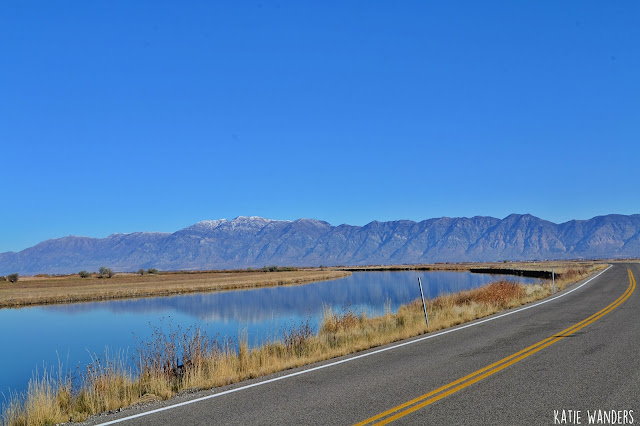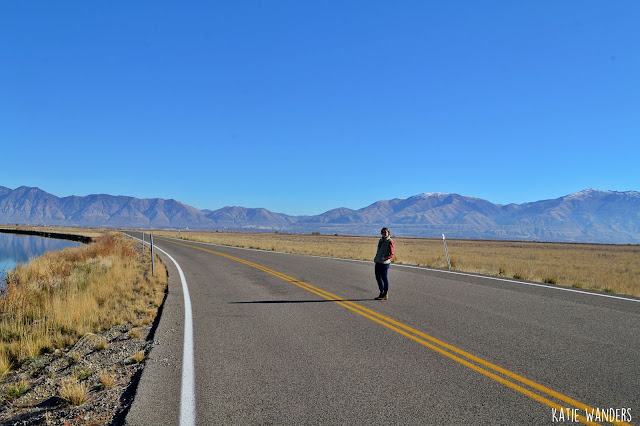Seventeen year old me wouldn't be caught dead at a bird refuge. The idea of walking around looking at birds would have initiated a horribly dramatic reaction. But twenty-seven year old me was pretty excited to check out a bird refuge.
You know you are getting old when....
It is that time of year when a lot of the great hikes are too snowy, and the ski mountains just aren't snowy enough. Sure, the mountains have opened, but I am a picky skier and when the mountains are so close (and so expensive) you wait for some pretty stellar conditions to bundle up. This time of year I am always looking for some alternative activities to keep me moving and out of this apartment on the weekend. Northern Utah is an area we really haven't explored much besides just driving through.
One of the best things about Utah, is there are so many hidden gems. I have come across so many adventures that even locals haven't discovered. While doing some research mid week, I cam across the Bear River Migratory Bird Refuge in Brigham City, Utah. I really only found this spot after zooming around portions of the Northern Utah map (that's how non hyped up this spot is).
The Great Salt Lake is a huge "layover" for migratory birds. and you can read more about what makes the Great Salt Lake such a perfect spot here. While you can see many birds on Antelope Island and in the Great Salt Lake, the "bird mecca" (and gorgeous scenery) is just north of the lake.
Following information from www.FWS.gov
What is it: Bear River Migratory Bird Refuge, on the northeast arm of the Great Salt Lake, offers phenomenal bird watching, especially in spring and early summer. Each year, millions of birds spend time on the refuge. A total of more than 200 species have been observed here.
Visit the James V. Hansen Wildlife Education to learn about the birds and habitat of the Great Salt Lake ecosystem through our interactive displays and watch the amazing Wings of Thunder film. This film was produced by the Friends of the Bear River Refuge and takes you on a 27 minute journey through our history and seasons of wildlife. A 1.5 mile walking trail meanders through the wetland habitat just outside the center.
A visitor center, boardwalk area, and a 12 mile-long auto tour route loops around large wetland units, giving birders close views of American Avocet, Black-necked Stilt, White-faced Ibis, Western and Clark's Grebes, Snowy Egret, Black-crowned Night-Heron, the occasional Snowy Plover, and many other species. The auto tour route is available for vehicles, bicycles and hikers and remains open year-round, weather and road conditions permitting. Restrooms, a teaching pavilion, boardwalk, interpretive panels and accessible fishing pier are located at the River Delta Interpretive Site, near the beginning of the auto tour route. You can download the audio tour for the auto tour HERE.
Directions: The refuge is located 12 miles west of Interstate 15 at Brigham City. Take Exit 363, Forest Street, and turn west to the refuge. Consult the refuge's "Birding Information Line" 435-734-6426 for a recorded message of recent sightings. The refuge operates a Wildlife Education Center in Brigham City, one block west of I-15 at the Forest Street exit (#363).
Distance: 12 miles out to the start of the auto tour, 12 mile loop on the actual auto tour (dirt road), and 12 miles back to the highway. 36 miles of beautiful Utah wetlands. The everglades of Utah if you will. NOTE 1: the 12 miles to the start of the tour is paved, while the auto tour is a 12 mile DIRT road that loops. In the Spring and winter the access road to the refuge may be covered with water or snow please call in advance to check road conditions. Tour Route may also be closed due to snow or water. NOTE 2: The Auto Tour is one way (counter clockwise). Please be courteous and pull over for others if you are stopped to view or photograph wildlife.
Hours: Like everything in Utah, the wildlife education center is closed on Sunday (this makes my blood BOIL- good luck finding anywhere to eat BTW). Visitor Center hours are 8:00 am to 5:00 pm weekdays, 10:00 am to 4:00 pm Saturdays, and is closed on Federal holidays. However, the Refuge auto tour route is open every day from sunrise to sunset every day of the year. There is an automatic gate that will open and close at sunrise and sunset hours.
Cost: Free! The National Wildlife Refuge System is operated within the U.S. Fish and Wildlife Service
Facilities: There are restrooms located at the visitors center, and at the start of the auto tour. Check out the map (above) for more information on facilities, boat ramps, and amenities.
Dogs and Family: This gorgeous area is perfect for a Sunday drive with the family, and you can even walk or bike the auto tour. The visitors center is great for adults and kids alike, and there is great educational signage all along the refuge. And guess what. Dogs are allowed (even off leash). My dog was a little too tempted with all the birds around, and they ask to not disturb wildlife. Probably the most interesting aspect of this spot was that they allowed hunting. When you see refuge, you think a safe place for birds. However, they do allow hunting by season and areas in the refuge. We did see many hunters (and their dogs) out on the refuge. Be aware of this if you do bring your kids to the refuge you will most likely hear gun shots.
Spring/Migration: In the spring, Bear River is active with life as birds fly back from the south. There is a continuous flow of different species in and out of the refuge. Each day offers something new. Birds are in their bright and colorful breeding plumage and the observant visitor can witness eons-old courtship rituals. Geese and ducks begin to arrive in early March. Shorebird migration lasts from early April through mid-May.
Summer/Breeding/Nesting: While some birds head further north to breed, over 60 species stay at Bear River through the summer to breed and raise their young. Baby birds can be seen as early as May when the Canada goose goslings make their debut. Later in June and July, visitors can view ducklings and young shorebirds such as American avocets and black-necked stilts. In July, the sight of young western grebes riding atop their parents' backs is especially exciting.
Fall/Migration: Beginning in July, shorebirds come back through the refuge on their way south and numbers peak in mid-August. Up to a half million ducks and geese concentrate on the refuge units. Over 30,000 tundra swans begin to arrive in mid-October and stay through December.
Winter/Residents & Visitors: From December to March, northern harriers, rough-legged hawks and prairie falcons frequent the marsh, searching the frozen land for prey. Bald eagles use the refuge in the winter for feeding and resting during the day. For more information on the which birds are on the Refuge and when....download the Monthly Bird Happenings fact sheet.
DISCLAIMER: If I am being honest, I am really not that into birds. Just not a bird person, sorry. But you don't have to be to enjoy this area. The scenery is absolutely stunning, and we sort of called it the "Everglades of Utah". If you love to get outside, or love to photograph wildlife then this is an amazing spot. I forgot my zoom lens so forgive my lack of bird pictures.
 |
Entrance to the (closed) visitors center and boardwalk.
Although the visitors center was closed, the auto tour is open 7 days a week. |


































No comments :
Post a Comment
Let's Chat!